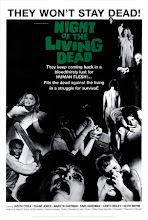 Welcome to the first in a series of Schlock Treatments devoted to a much-maligned, neglected and almost completely forgotten corner of the film world: Educational, Industrial or Training films, often referred to as “Ephemeral” cinema. Used as propaganda for clean and decent living, the Educational film was screened in every schoolroom, workplace, church and recreational facility right up until the early 80s, when the clattering old 16mm projector was finally replaced by the TV and video machine. With the demise of 16mm came the death of an entire artform, one with its own genres and sub-genres, and its unique aesthetics and conventions.
Welcome to the first in a series of Schlock Treatments devoted to a much-maligned, neglected and almost completely forgotten corner of the film world: Educational, Industrial or Training films, often referred to as “Ephemeral” cinema. Used as propaganda for clean and decent living, the Educational film was screened in every schoolroom, workplace, church and recreational facility right up until the early 80s, when the clattering old 16mm projector was finally replaced by the TV and video machine. With the demise of 16mm came the death of an entire artform, one with its own genres and sub-genres, and its unique aesthetics and conventions. Tonight it’s Sex Education, Schlock Treatment style, and we kick off with a prime example of the “What’s Happening To Me?” genre. It’s Wonderful Being A Girl from 1966 tries to explain to 12 year old girls what changes are occurring as they slam into puberty. Libby and Jean are two normal healthy girls, but are also different and unique in their own ways. “Libbies are Libbies, Jeans are Jeans,” the kindly narrator points out, and Libby just happens to be having her first period. Her Mom, a scarily toothy Betty Crocker type, teaches Libby how to put on a Modess brand pad (“They look like my regular panties!” she exclaims proudly), while her female teacher gives out free Modess calendars to she can plan ahead. And yes, this is a poorly disguised infomercial brought to you by Johnson & Johnson. The moral is: listen to your Mom, or your Mommy substitutes, and NOT the jaded, moody twelve year harridans around you who already refer to their menstrual cycle as “the Curse”.
Tonight it’s Sex Education, Schlock Treatment style, and we kick off with a prime example of the “What’s Happening To Me?” genre. It’s Wonderful Being A Girl from 1966 tries to explain to 12 year old girls what changes are occurring as they slam into puberty. Libby and Jean are two normal healthy girls, but are also different and unique in their own ways. “Libbies are Libbies, Jeans are Jeans,” the kindly narrator points out, and Libby just happens to be having her first period. Her Mom, a scarily toothy Betty Crocker type, teaches Libby how to put on a Modess brand pad (“They look like my regular panties!” she exclaims proudly), while her female teacher gives out free Modess calendars to she can plan ahead. And yes, this is a poorly disguised infomercial brought to you by Johnson & Johnson. The moral is: listen to your Mom, or your Mommy substitutes, and NOT the jaded, moody twelve year harridans around you who already refer to their menstrual cycle as “the Curse”.
 Girls Beware (1961) and Boys Beware (1961) are an infamous pair of “Stranger Dangers", companion films from the unbearably prolific Sid Davis Productions and made with the co-operation of the Inglewood Police Department. In Girls Beware, the voice of authority is a rather mannish policewoman named Norma, who mentally shuffles through her case files to narrate a series of sometimes horrifying vignettes on the dangers of teenagers trusting strangers. Judy gets her first babysitting job, and Norma has the odious task of telling Judy’s mom she is never coming home. Judy’s only crime: CARELESSNESS. Sally’s “ride” with older boys ends in more than tears, while Mary’s relationship with a maladjusted guy in his twenties careers out of control and she ends up under the protection of juvenile authorities. Suspect EVERYone, girls, including the boy next door: there’s rape, unwanted pregnancy and the shame of both, and murder, and all in less than ten minutes.
Girls Beware (1961) and Boys Beware (1961) are an infamous pair of “Stranger Dangers", companion films from the unbearably prolific Sid Davis Productions and made with the co-operation of the Inglewood Police Department. In Girls Beware, the voice of authority is a rather mannish policewoman named Norma, who mentally shuffles through her case files to narrate a series of sometimes horrifying vignettes on the dangers of teenagers trusting strangers. Judy gets her first babysitting job, and Norma has the odious task of telling Judy’s mom she is never coming home. Judy’s only crime: CARELESSNESS. Sally’s “ride” with older boys ends in more than tears, while Mary’s relationship with a maladjusted guy in his twenties careers out of control and she ends up under the protection of juvenile authorities. Suspect EVERYone, girls, including the boy next door: there’s rape, unwanted pregnancy and the shame of both, and murder, and all in less than ten minutes.
Boys Beware is narrated by the weary tones of Lieutenant Williams, who’s clearly seen more than his fair share of molested boys. Ominous music underscores a series of warnings to steer clear of the overly friendly adult male. “He may appear normal,” intones Lt Williams, but he is “sick – not visible, but contagious”. He is a homosexual… “This is the sickness.” Note the wording: not child molestors (who could theoretically be of either sex), but homosexuals. What follows is a series of red flag moments: hanging out in public toilets, accepting offers of free rides. Mike cheerfully takes a lift from the basketball court with a friendly adult; a wearier Lieutenant Williams hammers the point home that Mike didn’t realize he was “riding in the shadow of death”.

 The VD scare film is an evergreen genre amongst Sex Education films, and it doesn’t come scarier than VD Every 30 Seconds (1974). Whilst relatively light on the graphic footage (it is intended for a teenage audience), it’s heavy on the horror tactics and sledgehammer morality. The consequences of promiscuity – impotence, disease, madness and death – are presented in bizarre ways, from a stuttering sixteen year old with neuro-syphilis to images of arthritic limbs and dead babies, and a virtual Venereal Rapture, in which infants vanish from photographs (as if they never existed). All the while, the hateful second hand of a clock ticks its way towards the thirty second mark. Who now has VD? Is it you? You? Or YOU…..?
The VD scare film is an evergreen genre amongst Sex Education films, and it doesn’t come scarier than VD Every 30 Seconds (1974). Whilst relatively light on the graphic footage (it is intended for a teenage audience), it’s heavy on the horror tactics and sledgehammer morality. The consequences of promiscuity – impotence, disease, madness and death – are presented in bizarre ways, from a stuttering sixteen year old with neuro-syphilis to images of arthritic limbs and dead babies, and a virtual Venereal Rapture, in which infants vanish from photographs (as if they never existed). All the while, the hateful second hand of a clock ticks its way towards the thirty second mark. Who now has VD? Is it you? You? Or YOU…..?
 Pick-Up (1944) is a wartime sex education film posing as a
Pick-Up (1944) is a wartime sex education film posing as a
 Our final film tonight is a strange one, and considering our programming history that’s a big call. Tomorrow’s Children (1934) deals with Eugenics, a pseudo-science popular in the first half of the Twentieth Century which believed undesirable traits are passed on through genes; its Darwinist principles and theosophist ideas of racial purity were adopted by the Nazis amongst many other countries. In the United States eugenics took the form of social welfare programs aimed at curbing the population of those described as “genetically disadvantaged”, and resulted in the forced sterilization of over 60,000 civilians with mental illness, epilepsy, criminal tendencies and physical deformities (yes, even ugliness can be weeded out), the blind and the deaf, and those with Red Indian heritage.
Our final film tonight is a strange one, and considering our programming history that’s a big call. Tomorrow’s Children (1934) deals with Eugenics, a pseudo-science popular in the first half of the Twentieth Century which believed undesirable traits are passed on through genes; its Darwinist principles and theosophist ideas of racial purity were adopted by the Nazis amongst many other countries. In the United States eugenics took the form of social welfare programs aimed at curbing the population of those described as “genetically disadvantaged”, and resulted in the forced sterilization of over 60,000 civilians with mental illness, epilepsy, criminal tendencies and physical deformities (yes, even ugliness can be weeded out), the blind and the deaf, and those with Red Indian heritage.
 Tomorrow’s Children is
Tomorrow’s Children is
 The stigma of Hitler’s own eugenics program, which manifested in his Final Solution, contributed to its decline in the
The stigma of Hitler’s own eugenics program, which manifested in his Final Solution, contributed to its decline in the






















































































No comments:
Post a Comment